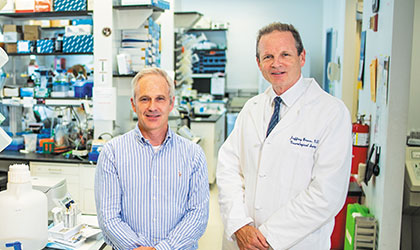Enhancing Convection-Enhanced Delivery

Dr. Peter D. Canoll and Dr. Jeffrey N. Bruce
“There are many drugs that are very effective at killing glioma cells, at least in the laboratory, but in order to get enough of the drug into the brain, you have to give a high enough dose, which causes too much toxicity in the rest of the body,” says Jeffrey N. Bruce, MD, Director, Bartoli Brain Tumor Research Laboratory, and Co-Director, Brain Tumor Center, at NewYork-Presbyterian/Columbia University Irving Medical Center. “Overcoming the blood-brain barrier poses an additional challenge by limiting the systemic delivery of therapeutics to the tumor.”
While studies have shown that prolonged infusion in small amounts improves survival, intracerebral convection-enhanced delivery (CED) has been limited to short durations due to a reliance on externalized catheters. “One of the problems in our earlier studies was that the catheters needed to be hooked up to a pump at the side of the bed, and we could only give the drug for about four days for fear of infection,” notes Dr. Bruce.
To address this, Dr. Bruce and his colleagues developed a novel drug delivery strategy that utilizes a microinfusion pump to establish a positive pressure gradient in the brain via an implanted catheter. The pump could be implanted in the abdomen to facilitate chronic infusion and is controlled by Bluetooth. This CED strategy has been pioneered in the Bruce and Canoll laboratories with basic studies to select appropriate anti-tumor agents, preclinical testing in animal models, and a phase 1 clinical trial in patients with recurrent malignant gliomas.
The researchers tested the delivery system in a porcine model. The infusion was tolerated without serious adverse events and a large volume of distribution was achieved. Following extensive preclinical studies, a phase 1 dose escalation trial of topotecan by CED was performed in patients with recurrent malignant gliomas with clinical, radiographic, and neuropsychological testing for toxicity and anti-tumor response. “We turned the pump on for two days and then off for five days for four rounds of treatment over a month,” says Dr. Bruce. “Median survival and median time to progression and at six months compared favorably with the best standard treatment available for this tumor group. The pilot study, the first of its kind, was recently completed and was successful in all patients.”
“There is another element of this research that is unprecedented in its efforts,” says Peter D. Canoll, MD, PhD, Director of Neuropathology at Columbia. “At the time of catheter placement and following treatment, many MRI-localized biopsies of the patient’s brain tissue are taken from the tumor and the surrounding infiltrated areas. Each of those biopsies is then analyzed for tumor content using immunohistochemical and molecular analyses. With two sets of biopsies pre- and post-treatment for each patient, we can directly assess the effects of the treatment in different areas of the tumor.” Furthermore, in collaborations with Peter A. Sims, PhD, Director, Columbia Single Cell Analysis Core, they are testing the effects of topotecan on surgical samples using single cell sequencing analysis.
“If we find a population of cells pre-treatment that have disappeared post-treatment, it’s very good evidence that they are being targeted by the drug,” says Dr. Canoll. "Because the analysis of the tissue is so comprehensive, it addresses another major obstacle. These are spatially and genetically hetero geneous tumors, so sampling these tumors is an unmet challenge. Most everything we know comes from a single piece of tissue. By taking biopsies from multiple areas and documenting their locations, we have been able to create a very large data set that not only captures the heterogeneity of each person’s tumor, but also allows us to make predictions about the unsampled areas of the tumor.”
“When we look at the tissue, it shows that the approach is working," says Dr. Bruce. "It's killing the tumor cells and it’s safe for the normal cells.”



